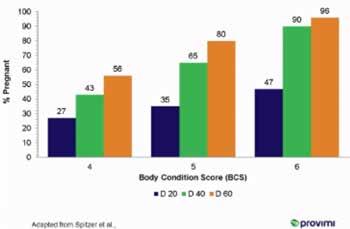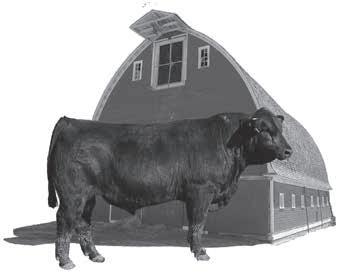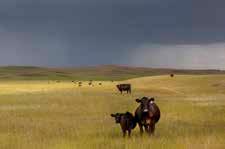
5 minute read
Nutritional Nonsense
GW CATTLEMEN’S COLLEGE Nutritional Nonsense: Myths Debunked
By Jake Renner
Depending on the reader, I’m doing one of two things as I reference a TV show from my childhood. You’re either going to wonder what the heck I’m talking about and jump on YouTube to find out, or you’re reminiscing about the cool slow motion tapes, that poor mannequin getting tossed off of every high-rise building, or the iconic beret worn by Jamie Hyneman. You guessed it: I’m referring to MythBusters, and today we’re going to be the myth busters of cattle nutrition.
I was lucky enough to sit in on a presentation from Wesley Moore, Ph.D., beef technical specialist, Cargill Premix & Nutrition, and Dusty Abney, Ph.D., cowcalf nutritionist, Cargill Premix & Nutrition, at the Cattlemen’s College held during the 2020 Cattle Industry Convention and National Cattlemen’s Beef Association Trade Show in San Antonio, Texas, in February. Moore and Abney set out to debunk some of the most common myths they hear in the world of cattle nutrition.
Myth: All my cows weigh 1,200 pounds!
Trends show over the past 40 years that the industry isn’t raising its grandads’ or dads’ cows any longer. Sure, producers may be using the same land, facilities, and tractor, but with the improvements made to genetics over the past four decades along with feed efficiency and proper land utilization, cows are surpassing the 1,200 pound mark grandpa/dad used to raise in the ‘70s. The amount of beef produced per cow has seen an 18% increase over the past 20 years. According to National Agricultural Statistics Service, carcass and live cow weight trends have increased substantially in the last 40+ years, as seen in Table 1, from the presentation. In 1974 live cow weights were averaging just over 1,000 pounds with a carcass weight average of 500 pounds. Jump to 2018 and both numbers have grown to support the notion that we are no longer raising our grandads’ cows in the twenty-first century. Instead, an industry average live weight is estimated at just under 1,400 pounds with a carcass weight of just over 620 pounds. That’s not to say that the 1,200-pound cow doesn’t still exist because she certainly does, but she’s just not the average.
What does this mean for our cows nutritionally? For every 100 pounds of cow body weight, it requires 2.2 pounds Total Digestable Nutrients (TDN) or a half pound more protein. The notion that producers can’t manage what they don’t measure is extremely critical when it comes to cow body weight, according to Moore. Cow body weight varies by condition, stage of gestation, season and environment, etc. “We truly need to know body weight when it comes to economic precision from a nutrition standpoint and let’s not pretend that all of our cows weigh 1,200 pounds,” Moore said.
Table 1. Myth: I can’t afford to feed those cows!
It may sound elementary, but the truth is that accurate body condition scoring (BCS) is a huge part of ensuring that our cows get bred. Can you breed a cow at BCS 3 or 4? The answer: eventually. If a breeding opportunity is missed, and yes, a low BCS can play a big factor in her cycle, that calf is 21 days younger, at 2 pounds a day on his/her dam’s side that’s 42 pounds lighter than he/she should be. In today’s market, that equates to $50 to $60 out of a producer’s pocket all because of a missed a breeding opportunity, according to Abney.
Fetal programming: What happens to the cow during pregnancy does have lifelong implications for the calf that affect the operation’s bottom line. If the goal is to keep heifer calves as replacement heifers, a cow that was bred at a BCS 5-6 on the first cycle calves earlier and will likely breed back earlier (if nutritional
requirements are continually met). In turn, the heifer calf is set up with the right tools and on the right schedule to also breed earlier, calve when she’s supposed to and serve the operation the best she can. If you don’t take care of that cow, she can’t take care of her calf.
Table 2 is from 1995, but is still very much relevant in today’s industry. BCS not only affects conception rates, but also the timing of rebreeding. Moral of the story, match cows to the environment and invest in supplementation when needed for improved conception rates. Investing in herd nutrition is investing in the future of the operation. With this said, producers shouldn’t spend the extra money getting cows past a 5.5-6 BCS.

the necessary information to make the best decisions from a feeding standpoint on our operations. Instead, make sure to deal with reputable manufacturers and ask for more information when necessary, including questions about the energy content of the feed in terms of total digestible nutrients (TDN) or net energy for maintenance (NEm), whichever one the producer is more comfortable utilizing, according to Moore.
Are salt blocks a complete mineral supplement? The answer is no. Salt blocks are made up of, you guessed it, SALT. They’re also a great source of, again, SALT. They are not a complete vitamin/mineral program regardless of what color they come in. The color of salt block comes from coloring agents, not minerals. Cows need access to mineral every day and it must be something they’ll eat. And…it sounds simple, but in order for cows to get the minerals they need, including salt, the producer has to put it out there for them to eat, according to Abney. D
Table 2 Myth: Fat on a feed tag equals calories!
“Fat is a caloric dense substance, and itself does equal calories, but fat on a feed tag may or may not equal calories depending on what the rest of the formula looks like,” Moore said.
The tag does however tell us the crude protein, crude fat and crude fiber; everything else is a vitamin or mineral. We know how much protein is in our feed, but not the quality. We know how much fat is in our feed, but realistically how big of an influence does fat have on calories in that feed? Lastly, we know how much fiber is in the feed but not how digestible it is. The simple truth is, there is no good measure of calories on commercial feed tags. Fat does not guarantee energy content and crude fiber is also not a good indication. Fat does not elude to the caloric density of the feed. The feed tag alone does not give us
Bull Barn Genetics For all your AI needs:

• Gelbvieh • Angus • Red Angus • Simmental • Club Calf
• Salers • Shorthorn • Dairy • Charolais • Hereford
• Sheaths • Gloves • Cito Thaw Units • Tanks • A.I. Kits • Arm Service
Eldon & Kathy Starr 210 Starr Dr • Stapleton, NE 69163 bullbarn@bullbarn.com • 800-535-6173 www.bullbarn.com




